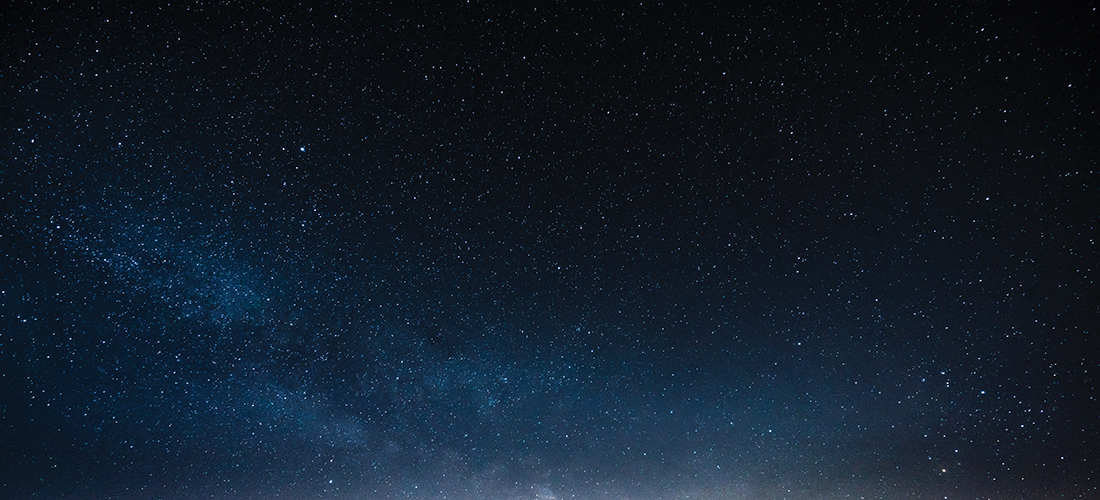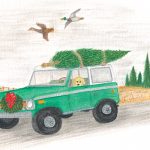
A Walk in the Dark
The nocturnal world reveals its secrets — and the beauty of an Elephant Angel
By Jim Dodson
Every morning for the past few years, a couple of hours before sunrise, while much of the world has yet to stir, regardless of weather or season, my wife and I walk a mile with our dogs through the darkness. Sometimes a little farther than that.
Neither wind nor rain, neither sleet nor snow — and certainly not dark of night — can keep us from our appointed rounds.
What began as a simple way for two humans and three canines to get their feet and bloodstreams moving has become a daily ritual that seems almost second nature now, the one time during a busy week when we — the humans — have time to talk and walk or simply be together. We talk of many things or nothing at all, frequently walking in a mindful silence worthy of Benedictine monks.
We carry a flashlight to shine if necessary but prefer to travel by the light of the stars and an ever-changing moon, plus whatever illumination hails from the odd lighted porch or lamppost.
Fortunately our neighborhood has only a few street lights, which make night skies more vibrant and provide deep stretches of darkness where we rely on faith and trust that one of us won’t step headfirst into an open manhole or fall over someone’s curbed bag of leaves.
That’s a risk I’m happy to take. We live in a world too full of clamor and noise, and save for those wee hours when maintenance crews at the nearby shopping center operate industrial-sized leaf blowers that can be heard for country miles (against city noise codes, by the way, and something that has many in the neighborhood up in arms). The predawn silence and stillness may be the best thing about a walk in the dark, a healing glimpse of a world that was. “Silence is the sleep that nourishes wisdom,” said Francis Bacon.
Our two older dogs — Mulligan the aging mixed breed foundling (Queen bee, deaf in one ear) and Ajax the golden retriever dandy (pedigreed goofball) — know nothing of Bacon, except the kind they beg to eat, but do know the way by heart though the darkness, chugging bravely ahead. Gracie, the sweet young Staffordshire terrier we rescued from life on the streets, likes to pause and sniff the earth where others have passed, keeping a sharp eye out for breakfasting rabbits, still learning her way through a civilized world.
Darkness, it seems to me, gets a pretty bum rap.
As kids, we are programmed against the night by popular culture and to fear the darkness and everything that potentially lurks therein — the monster in the closet, the bogeyman beneath the bed, witches who consort with the moon, robbers waiting in the bushes, black cats and burglars on the prowl.
Later in life, of course, it’s the metaphorical darkness that drives the daylight narrative with news of yet another incomprehensible mass murder of innocents in broad daylight by some despondent loner enveloped by his own inner darkness.
Friends — and everyone has them — who’ve made the journey through the Stygian darkness of depression live in a state of perpetual twilight, unable to sleep, untethered from a world that seems to hold scant promise of joy or hope. Their journey back to the light is one of the bravest things you can witness.
Meanwhile, the Web’s dark side is reportedly shadowing all of our lives, spinning fantastic conspiracies while stealing our identities and credit card numbers. Is it a coincidence that the television ads that run in the predawn hours aggressively peddle home security systems, identity protection and male impotence cures? Probably not. These are what we fear most in our darkest hours of the night.
And yet, it is that very darkness where we take refuge and rest and recharge batteries, snuggle down beneath the duvet, temporarily abandon all cares and set loose on travels through our dreams. For all its magnificent abilities to reveal the workings of living creatures, modern science still cannot fully explain why all living things — even honeybees — need sleep. But thankfully we do. And the best benefits of sleep occur, sleep experts agree, in a dark and silent place.
A campfire in the daytime seems, well, rather pale and pointless. But on a dark night in the wild, surrounded by the watchful eyes of living creatures great and small, what is more comforting than a crackling fire that sends up sparks to heaven when you toss on another log?
In her marvelous book Learning to Walk in the Dark, spiritual writer Barbara Brown Taylor points out that the human body requires equal amounts of darkness and light to function properly, an ancient circadian rhythm of sleeping and waking that matches the cycle of day and night, allowing natural healing properties in both man and nature to do their thing.
“I have learned things in the dark that I would never have learned in the light,” Brown writes, “things that have saved my life over and over again, so that there is really only one logical conclusion. I need darkness.”
“Someone I loved once gave me a box full of darkness,” concurs the poet Mary Oliver. “It took me years to understand that this, too was a gift.”
Madeleine L’Engle sagely chimes in from a wrinkle somewhere in time, “Maybe you have to know the darkness before you can appreciate the light.”
Which brings us happily back to lights on our daily walk made mythical by the winter darkness.
Beginning in October (seemingly earlier every year), it’s fun to see the year’s latest crop of illuminated creatures of the night that appear on lawns weeks before Halloween — gigantic black cats, towering ghouls, giant spiders, fake graveyards, skeletal hands reaching up from the azaleas. It’s all in good fun, meant to mock the very thing we are meant to fear: the mysterious darkness.
Our favorite by a wide margin is the Great Lighted Pumpkin that appears every year at the start of October, floating high in the limbs of an ancient white oak near the corner where we turn for home. He smiles benevolently upon us as if he gets the joke — a beacon of cheerfulness in a season of manufactured fright.
Come December — the hemisphere’s darkest month — it’s the deep winter darkness that makes the lights of our daily trek through the neighborhood such a visual feast, a kinetic pleasure. As the curtain comes down on another year in the life of this struggling old planet, we hopeful types dutifully light candles and build bonfires to politely rage against the notion of going gently into that good night.
As if to indicate our unwavering commitment to optimism in the face of present concerns, we string lights on trees and lampposts, erect illuminated reindeer and waving Santas, blinking constellations of shrubs meant to light the darkened way. Clearly, there is a message in this.
During the years we resided on a coastal hill in Maine, surrounded by several hundred acres of a deep beech and hemlock forest, our little ones lived for the annual lighting of trees around the property, particularly an elderly American beech that stood in the side yard off the eastern porch.
In order to get up into the limbs of the old tree, I needed a large step ladder and a healthy snort of good Kentucky bourbon for courage in order to finagle the tiny lights into the highest branches. Our resident squirts maintained that the creatures who resided in the surrounding forest — a peaceable kingdom that included a family of white tail deer, a lovesick moose who occasionally wandered over the lawn, a fat lady porcupine who waddled past and a flock of wild turkey, not to mention a couple mischievous made-up story time bears named Pete and Charley — needed our lit-up beech to brighten their cold winter nights.
Not everyone grasped this. The UPS guy, for example, wondered why we bothered to put up holiday lights on a forested hilltop where nobody but us could see them.
Before I could reply, my wee son Jack spoke up.
“The birds can see them,” he calmly explained. “And so can angels.”
One year, in any case, I forgot to check whether the current bulbs were still operational and carefully put up several strings only to discover they were dead as Jacob Marley’s doorknocker.
In frustration, I went out and purchased several new strings of holiday lights and tested them before haphazardly flinging them into the limbs as darkness fell and an intense downpour of sleet began.
Upon flipping the switch, something remarkable happened, proof that children see things that grown-ups lose the ability to see without help.
The old beech bloomed to life with glittering lights in the icy darkness and I breathed a sigh of relief.
“Look, Daddy,” Jack said matter-of-factly. “An elephant angel.”
By golly he was right. I can only describe what he saw — the outline of an elephant with wings, soaring heavenward — as exactly that.
A few days later, even the UPS guy, delivering Christmas presents from faraway Carolina, was deeply impressed. PS
Contact Editor Jim Dodson at jim@thepilot.com.





